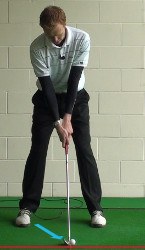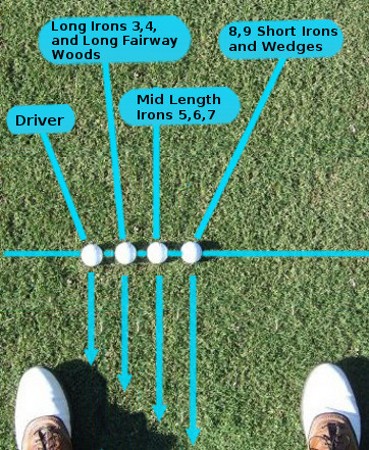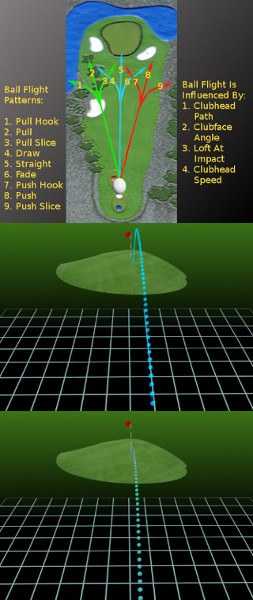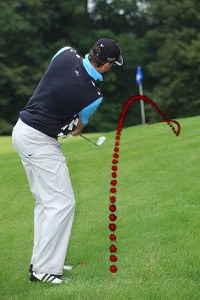
One of the many things that set tour pros apart from amateurs – even very good ones – is the ability to control the ball's trajectory.
This is an important factor in windy conditions, but also when playing to different pin placements, carrying distant hazards or hitting a shot that runs after landing.
 There's no real magic to altering the height of your shots. It's largely done by changing the ball's position in your stance, which determines the club's effective loft at impact. As a simple rule, the farther up in your stance you play the ball – toward the left foot, for a right-hander – the higher it will fly. Play it farther back, or to the right, to produce a lower flight.
There's no real magic to altering the height of your shots. It's largely done by changing the ball's position in your stance, which determines the club's effective loft at impact. As a simple rule, the farther up in your stance you play the ball – toward the left foot, for a right-hander – the higher it will fly. Play it farther back, or to the right, to produce a lower flight.
It's important to keep the hands ahead of the ball and the shaft leaning toward the target on iron shots. The farther back you play the ball, the more the shaft will lean.
This “de-lofts” the clubface for a lower trajectory. The same concept applies on chips and bunker shots.
Golf Ball Videos:
- Compression Video
- Spin Video
- Dimples Video
- Golf Ball Brands Video
- Titleist Video
- Understanding Spin Video

Control Trajectory by Varying Ball Position
The ability to control the trajectory of your shots might seem like a skill that is a bit out of reach. After all, as an amateur golfer, you don't have the control over your ball which is demonstrated by the top pros. However, even if you have a lot of work to do on your game, it is still worth your time to learn how to alter your trajectory on command. Not only will you add some new shots to your game as you learn this skill, but you will also improve the overall quality of your swing in the process.
One of the best ways to control the trajectory of your shots is by varying the ball position you use at address. When you set up over the ball, you have to determine where you are going to stand in relation to the position of the ball on the ground. Are you going to line up with the ball in the middle of your stance, or up toward your front foot? Or, are you going to play the ball back in your stance, closer to your right foot (for a right-handed golfer)? Choosing your ball position is one of many decisions that needs to be made before you can go ahead with a swing. This is an important decision, of course, as it is going to largely determine the type of trajectory you use for the shot.
Many amateur golfers make the mistake of trying to make dramatic swing changes when they want to produce a different-than-usual ball flight. Generally speaking, that is just not necessary. Instead of changing your swing in any significant way, try adjusting the location of the ball within your stance. While it is difficult to make swing changes on the fly, it is quick and easy to change where you are standing in relation to the ball. As long as you practice these adjustments before you play – so you know what they will do to the flight of the ball – you can use this method to experience great success.
While it is true that ball position adjustments are a powerful way to change your trajectory, there are some minor swing tweaks which will be needed as well. As mentioned in the previous paragraph, you don't want to make any dramatic or drastic changes to your swing mechanics as you play – but you will need to slightly alter the way you swing the club in order to generate a variety of different ball flights. When you bring together the right ball position with the proper swing technique, impressive results are possible.
All of the content below is based on a right-handed golfer. If you happen to play left-handed, please take a moment to reverse the directions as necessary.
Golf Ball Videos:
- Compression Video
- Spin Video
- Dimples Video
- Golf Ball Brands Video
- Titleist Video
- Understanding Spin Video

Understanding the Basics
If you are an experienced golfer, you may already understand the basics of how ball position can impact your trajectory. If you are a beginner, you may have no concept of how this works. Either way, it will be beneficial to review the information below. By having a clear understanding of what various ball positions should do to your trajectory, you can quickly dial up the right one needed for the shot at hand.
The following points will outline the basics of how ball position impacts shot trajectory on the golf course.
- Move the ball forward to hit higher shots. Moving the ball 'forward' in your stance means moving it closer to your left foot. When you make this adjustment, the club will have more effective loft at impact, and the shot will fly higher than it would when played from farther back in the stance. For example, if you hit a seven iron shot from the middle of your stance, you will likely see an 'average' trajectory in terms of height. If, on your next swing, you move the ball up in your stance by a couple of inches, the next shot should fly higher into the sky (assuming you make solid contact, of course). This minor ball position adjustment is one of the easiest ways to produce higher trajectories on demand. With practice, you will get a feel for how much you need to move your ball position in order to achieve various heights. This equation will change as you hit different clubs from different lies, so there is no substitute for experience when learning what to expect out of your variety of ball position options.
- Move the ball back to hit it lower. This was the logical point to follow up the previous item on the list. If moving the ball forward in your stance is going to help you hit it higher, moving the ball back will obviously help you to hit it lower. It doesn't take much of an adjustment to hit a dramatically lower shot, either. To continue the previous example, imagine you moved the ball a couple inches back from center when hitting your seven iron. While playing from behind center in your stance, you will get an extremely low ball flight capable of cutting through the wind and maybe even offering some bounce and roll after it lands. This is a shot which is useful in many situations around the course, and it is one that every golfer should have in his or her bag.
- Stand farther away to hit a draw. When the average golfer speaks of ball position, they are generally talking about moving the ball left or right in their stance, as seen from address. However, that is only one half of the equation. Also, you need to think about how far you are standing away from the ball. You should have a 'standard' distance you stand from the ball for normal shots, and you can then adjust from there to alter your trajectory. In this case, if you want to hit a draw, you are going to stand a little bit farther away. Moving back away from the ball will cause your swing to flatten out, and you will be more likely to trace an inside-out path through the hitting area – leading to a draw. Also, with plenty of room between yourself and the ball, you should find it easy to release the club properly at impact. When facing a shot where a draw is absolutely essential, moving back a couple inches farther away from the ball should do the trick.
- Stand closer to the ball to hit a fade. Again, this is another obvious point based on the previous explanation. Standing closer to the ball is going to make it more likely that you will produce a fade based on the adjustments which will take place in your swing. Your swing plane is going to become more upright, meaning you may attack the ball from an outside-in path. Also, it will be hard to release the club fully at impact without as much space between your body and the club, so you will be more likely to hold the face open slightly. When you add it up, you are left with a swing which should produce a reliable left-to-right shot pattern time after time.
The four points above are all you need to know about the basics of controlling your trajectory through the use of ball position. Wish to hit the ball higher? Move it toward the front of your stance. Need to hit it lower? Move it back a couple of inches. Want to hit a draw or a fade? Stand farther away, or closer, respectively. It will take a little bit of practice to learn how to execute on these adjustments, but the basic framework of this part of the game is easy to understand.
Golf Ball Videos:
- Compression Video
- Spin Video
- Dimples Video
- Golf Ball Brands Video
- Titleist Video
- Understanding Spin Video

Minor Swing Adjustments
As was mentioned in the opening of this article, there are a few minor swing adjustments you will need to make in order to optimize your results. These are not dramatic changes, however, they are still quite important. If the ball is going to behave in the manner that you would like while in the air, you need to make a swing which leads it in the correct direction.
Fortunately, there isn't anything you need to do when it comes to favoring a draw or a fade by changing your distance from the ball. If you are trying to curve the ball in one direction or another, you can simply stand closer or farther away and then make your usual swing. The beauty of adjusting your ball position in this case is the fact that you don't need to do anything mechanical to alter the direction of the curve. The ball position change does the work for you, so trust it and swing away with confidence.
The same cannot be said for hitting your shots higher or lower. When you move the ball left or right in your stance to change the height of the trajectory, you need to make a couple of associated changes to your technique in order to see good results. Those changes are outlined below.
- Higher shots. When trying to hit the ball higher, you are going to start by moving the ball slightly to the left in your stance. Once that is done, you can turn your attention to the manner in which you are going to swing the club. The key here is to stay balanced and rotate nicely through the downswing. It will be tempting to slide to the left as you swing down, since the ball is going to be resting farther to the left than usual. This slide to the left would be a mistake. The whole point of adjusting your ball position is to catch the shot just after the bottom of your swing – but if you slide left, you will be shifting the bottom of your swing to the left, negating the benefit of changing your ball position in the first place. Instead of that slide, focus on great rotation while making a full release of the club through impact. It is that release which will allow you to expose all of the loft of the club to the ball when contact is made.
- Lower shots. Most likely, you are going to attempt to hit the ball lower far more often than you will attempt to hit it higher. Of course, you are going to start this process by moving the ball back in your stance. Then, turn your attention to making a controlled, balanced golf swing. Your weight should stay perfectly between your two feet throughout the backswing, and you should keep your head down all the way through impact. When trying to hit the ball low, you want to restrict your release, so swing only to an abbreviated follow-through to make sure you aren't releasing the club too dramatically. The back of your left wrist should feel firm and flat at impact. It takes some practice to get comfortable with the truncated swing needed to hit low shots, but this will be a powerful weapon in your arsenal once it is mastered.
The best way to learn how to adjust your swing is simply to practice these shots on the range. During your next practice session, spend some time trying to hit shots both higher and lower on command. Through this process, you will learn which adjustments work for your swing, and which ones don't. Once you can reliably produce high and low shots on the driving range, you will be ready to take this newfound skill out onto the course.
Golf Ball Videos:
- Compression Video
- Spin Video
- Dimples Video
- Golf Ball Brands Video
- Titleist Video
- Understanding Spin Video

Picking Your Spots
It is one thing to learn how to hit a variety of different trajectories – it is another thing to learn how to use those trajectories effectively. Shot selection is an important skill in golf, as hitting the right shots at the right time is almost as important as being able to hit those shots in the first place.
The best comparison in sports that can be made for shot selection in golf is to think about a pitcher in baseball. Any given major league pitcher is going to have at least two different pitches he can throw, and most pitchers will have three or four. In addition to being able to physically throw the pitches, a pitcher also has to pick the right one to throw at the right time. If a pitcher throws a fastball when a curveball would have been a better choice, for example, the outcome could be a disaster. Just like the pitcher in baseball, you have to know exactly when to reach for your various trajectories in order to optimize your results.
To get started on improving your shot selection, the first rule of thumb to remember is this – always use your 'stock' shot whenever possible. Your 'stock' shot is the ball flight that will be produced when you make a normal swing with no adjustments. As long as the shot you are facing can be handled with that standard ball flight, you should stick with it and avoid any changes. You only want to make changes to your game plan when the course forces you to do so.
What kinds of situations could arise which would force you to alter your approach? Consider the following points.
- Low shots in the wind. This is probably the most obvious point of all, but it is an important one to remember. When playing in the wind – no matter what direction that wind is blowing – your best bet is to keep the ball low to the ground. Hitting high shots in the wind takes away much of the control you have over the ball, and you never want to give up control in this game. Learning how to hit low shots around a windy golf course will allow you to score much better when conditions are tough.
- Low shots to back hole locations. Another great time for a low iron shot is when you are attacking a hole location found in the back of the green. Rather than flying the ball all the way to the hole, and risking a shot that flies over the green, hit a low approach and bounce the ball back toward the cup. There is a greater margin for error with this shot, and you will still have a chance to hit it close in order to set up a birdie putt.
- High shots to front hole locations. You aren't going to be able to take the ball in low when hitting an approach to a hole located on the front of the green, because you won't have room for the ball to bounce and stop. Therefore, you should hit this shot high and bring it down softly somewhere around the cup.
- Aim to the center and curve toward the edges. When facing an approach shot to a green with the hole cut near an edge, try to aim the ball at the center of the putting surface and curve it off of that point. This strategy is ideal because you won't be punished for a straight shot. If the ball flies straight, you will find it in the middle of the green and you can putt from there. If it does curve in the intended direction, you will have an even better look at your putt.
- Use curves to deal with doglegs. When standing on the tee of a par four or par five with a large dogleg in the fairway, use a draw or fade shape as necessary to position your ball in the fairway. Even if you aren't perfectly accurate with these kinds of shots, turning your ball in the same direction as the hole will give you a great chance to wind up with a nice tee shot.
Keep your mind open to various types of shots while on the course, while at the same time always defaulting back to your 'stock' shot whenever possible. Over time, you will develop a style of play which is a nice blend of standard shots and altered ball flights to match the demands of the course.
Golf Ball Videos:
- Compression Video
- Spin Video
- Dimples Video
- Golf Ball Brands Video
- Titleist Video
- Understanding Spin Video

Ball Position Around the Greens
Trajectory is something you think of when hitting full shots, but it matters in the short game as well. Fortunately, the same general rules apply for chip and pitch shots as they do for full swings, so you can take what you have learned in the long game and apply it to your short game. Need to hit a high chip shot which lands softly on the green? Move the ball up in your stance. Need to pitch the ball low to the ground so it will run out after it lands? Move the ball back closer to your right foot.
When chipping and pitching, you don't need to worry about the curve of the ball, as these shots will not be in the air long enough to draw or fade. However, you still want to pay attention to the distance that you stand from the ball at address. You need to be in a comfortable position, and your arms should have room to swing freely through the hitting area.
As was the case with the full swing, the best thing you can do to find the right ball positions in your short game is to practice. Hit chip and pitch shots from a variety of ball positions to see how the ball reacts both in the air and after it lands. By having as many shots as possible available to you out on the course, you will be able to deal with a wide variety of circumstances which may come up in the short game.
Ball position is a key fundamental in golf. You need to stand in the appropriate position next to the ball in order to create the right type of shot for the situation at hand. Pay close attention to this part of your game during upcoming practice sessions and you should find that it can quickly help you to play better golf on the course. Good luck!
Golf Ball Videos:
- Compression Video
- Spin Video
- Dimples Video
- Golf Ball Brands Video
- Titleist Video
- Understanding Spin Video






